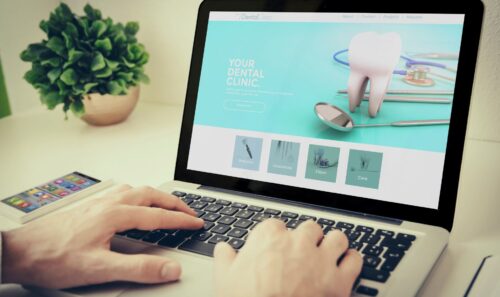When it comes to search engine optimisation (SEO), things can often become very technical. Conversation circles around terms like technical performance, health scores and indexing, and before long, you’re down a rabbit hole of confusion.
Adding to its mystique are the many different factors for SEO success, from what’s on your website to how it runs. There are also things that you might not be able to control, such as the framework within which your site was built, and elements that can’t be changed. The key to success lies in identifying what can be changed and making the most of this.
SEO is extremely important in helping any dental practice increase its visibility. This is because the higher your ranking in search results, the higher the number of clicks being made through to your website. We’ve found that there’s a vast difference in the number of clicks from a top-three result, compared with even a tenth-position result. For instance, did you know that the #1 organic result is ten times more likely to receive a click compared to a page in the #10 spot?
This much is probably quite widely known. What may surprise people, however, is that there are different types of SEO. Two of the most important to know about are organic and local.
What is organic SEO?
Organic SEO is probably the type that we hear most about. This includes optimising the back end of your website (everything a user doesn’t see) and the content within it. Here, we enter the realm of onsite SEO, where you identify the keywords and topics that patients are searching for and try to be found for them. Organic search also includes the structure of your site: internal links, load time, suitability for mobile devices, and what we might broadly describe as “the things you do to show in searches”.
It also includes the practice of improving a website’s search engine ranking by optimising factors outside of the website itself. This can be done by securing high-quality backlinks, promoting the website on social media, and other forms of digital marketing. The goal is to increase the website’s authority, reputation, and relevance in the eyes of search engines, which can result in higher search engine rankings and more organic traffic to the website.
The advantage of organic SEO is that it can be very cost effective. You’re not paying for adverts, so costs are only associated with work to build visibility and boost searchability (for instance, paying an agency for keyword and backlink research). This amounts to a fixed fee for an increase in traffic and near constant, 24/7 visibility; that is, assuming your work is successful.
The only snag is that this approach involves a lot of maintenance. It’s not enough to “do” SEO and check it off your list; to remain above your competition, you need to be more visible, and to be more visible, you need to have more and better content. For instance, if you have one page dedicated to Invisalign, with 100 words of content, but your competitor has one page with 500 words, they’re likely to be preferred as the top result. However, if you supplement your page of content with four blog posts also exploring the topic, you’re more likely to leap-frog them and become the authority.
Some treatments are highly competitive, with many practices vying for the top spot. This means that realistically, you can’t always optimise your site for every treatment; but you can optimise every page for search. By doing this, you’ll secure a good volume of traffic, which gives you a greater opportunity to convert your website visitors.
Another disadvantage of organic SEO is that it takes time to change and update things on your website. This applies to both your time, physically implementing changes, and to search engines, which take time to “index” (or log) that things have been changed. You may have to wait between three and six months to see the rewards of your SEO tactics. It’s best to think of organic SEO as a valuable strategic investment, rather than an immediate solution.
And finally, there are pesky algorithm updates to watch out for. Search engines don’t always like to show their workings, so some changes to their functionality will remain a secret. Google carries out core updates multiple times each year, which can usually only be fully understood when we begin seeing their impact. It’s therefore best to keep your finger on the pulse and understand any changes, to make the best of your website.
What is local SEO?
Local SEO is slightly different. This form of SEO relates to the rising numbers of people searching with local intent; for instance, using search terms that include the phrase ‘near me’. Results are also displayed differently, using business profile listings. This means that to capture the audience, you’ll need to work differently too, optimising both your site and your business profile.
The easiest and best first step is to claim your Google Business Profile. Within this, you can add key information, including your opening times, details of your offering, and your location. Make the most of other profile opportunities, such as adding photos and linking to your services.
It’s also very helpful to begin populating your profile with good reviews, as this helps you to compete. To do this, encourage or help patients who’ve received a good service to leave you a review. You might ask for them directly, or choose to automate the process, using a platform such as Working Feedback. Once someone has left a review, be sure to reply to it. This shows that you’re responsive and responsible, offering good customer service.
Citations – links to directories – will also boost your local SEO. However, absolute consistency is crucial, so be sure that every link has your correct name, address and telephone number. Monitor these to ensure that they’re accurate, and you’ll find it’s ultimately worth the effort.
Like organic SEO, one disadvantage of local SEO is that it takes time. Search is never-ending, so you’ll need to keep on top of it, adapt, and add fresh content, links and reviews. However, the more you do, the greater the reward. To help yourself, establish processes and standards, or if you’re short on time, work with an agency (such as Hive) that specialises in dental industry SEO.
Why do both?
We always say that it’s good to dominate search. If you dedicate time to boosting both your organic and local search, you’ll be in a far stronger position than you would be with only one base covered. By focusing on both organic and local, you’ll be targeting a broader and wider range of search terms. This means even more chances to appear in listings, and more opportunities to direct users to your site.
And, if you have the budget to invest in advertising, you could even be in the winning scenario of having an advert at the top of a results page, followed by your local listing, followed by a link at the top of the organic listings. Three results for your practice on one results page will have a huge subconscious impact on browsers when it comes to brand awareness. In this example, there are three chances that a user will click through to you.
So, how can you make it happen? It’s possible to do this yourself (Google Business is fairly easy to manage), but be warned: this approach is time intensive. With only so many hours in the day, many practice owners prefer to find an agency who’ll take care of things on their behalf.
A good agency will look at the volume in the market and select the terms that will be most beneficial for you, based on the type of traffic you want. Importantly, they’ll also review and change tack as you go along, considering how searches are evolving, and what your competition is doing.
If you’d like to speak to us about optimising your online presence, get in touch for a chat with our marketing team.








